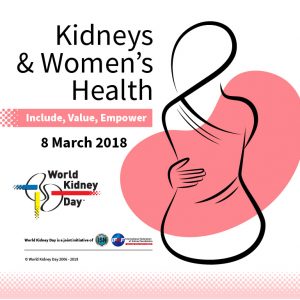Chronic kidney disease (CKD) is a worldwide public health problem with adverse outcomes of kidney failure and premature death [1]. CKD affects approximately 195 million women worldwide and it is currently the 8th leading cause of death in women, with close to 600,000 deaths each year [2]. .
The risk of developing CKD is at least as high in women as in men, and may even be higher. According to some studies, CKD is more likely to develop in women compared with men, with an average 14% prevalence in women and 12% in men [3]. However, the number of women on dialysis is lower than the number of men. At least three major reasons are recognized so far: CKD progression is slower in women compared to men, psycho-socioeconomic barriers such as lower disease awareness lead to late or no start of dialysis among women [4] and uneven access to care is a major issue in countries with no universal access to healthcare. Kidney transplantation is also unequally spread, mostly due to social, cultural and psychological aspects: even in some countries that provide kidney transplantation and equitable treatment for men and women, women tend more often to donate kidneys and are less likely to receive them [5]. There is indeed a clear need to address issues of equitable healthcare access for women where it is currently lacking and increase awareness and education to facilitate women’s access to treatment and better health outcomes.
Lupus Nephropathy & Kidney Infection
Some kidney diseases, such as lupus nephropathy or kidney infection (acute or chronic pyelonephritis) typically affect women. Lupus nephritis is a kidney disease caused by an autoimmune disease, which is a disorder in which the body’s immune system attacks the own cells and organs [6]. Pyelonephritis is a potentially severe infection that involves one or both kidneys [7]. Kidney infections (as most urinary tract infections) are more common in women and the risk increases in pregnancy. To ensure good results, as most renal diseases, diagnosis and treatment should be timely.
Kidney Disease & Pregnancy
CKD is also considered a risk factor for adverse pregnancy outcome and reduced fertility. Women who have CKD are at increased risk for negative outcomes for the mother and the baby; pregnancies in women with advanced CKD are most challenging with high rates of hypertensive disorders and preterm births [9]. They may have reduced fertility but conception is possible, even if infrequent, on dialysis. On dialysis, results improve with intensive (daily or nearly daily) dialysis treatment, thus calling for dedicated programs for women of childbearing age [10].
In successfully transplanted women, fertility can be restored and chances of successful birth increase. However, as complications are observed more often than in the general population, preconception medical counselling should always be sought. There is a clear need for higher awareness on CKD in pregnancy, to timely identify CKD in pregnancy, and to follow-up women with CKD during and after pregnancy. In this respect, pregnancy may be also a valuable occasion for early diagnosis of CKD, thus allowing planning of therapeutic interventions.
In turn, pregnancy-related complications increase the risk of kidney disease: pre-eclampsia, a syndrome in which a defect of the implantation of the placenta affects normal kidneys inducing hypertension and proteinuria, is one of the 3 leading causes of maternal mortality [8]. Preeclampsia, septic abortion (infection of the placenta) and post-partum haemorrhage (major bleeding after giving birth) are leading causes of acute kidney injury (AKI) in young women, and may herald future CKD in survivors [11].
The burden of those maternal complications is particularly high for women in developing countries, due to insufficient access to universal and timely prenatal care, to improper management of women with preeclampsia, and to lack of availability of dialysis for severe AKI [12].
Our Message
There is a clear need for higher awareness, timely diagnosis and proper follow up of CKD in pregnancy. In turn, pregnancy may be also a valuable occasion for early diagnosis of CKD, allowing planning of therapeutic interventions.
On this occasion, World Kidney Day and the International Women’s Day 2018 are commemorated on the same day, offering us the opportunity to reflect on the importance of women’ s health and specifically their kidney health. On its 13th anniversary, World Kidney Day promotes affordable and equitable access to health education, healthcare and prevention for kidney diseases for all women and girls in the world.
References:
- Kidney Disease: Improving Global Outcomes (KDIGO) CKD Work Group. KDIGO 2012 Clinical Practice Guideline for the Evaluation and Management of Chronic Kidney Disease. Kidney inter., Suppl. 2013; 3: 1–150.
- Data on prevalence and mortality in women taken from GBD website: https://vizhub.healthdata.org/gbd-compare/
- Global Prevalence of CKD – A Systematic Review and Meta-Analysis: https://www.ncbi.nlm.nih.gov/pmc/articles/PMC4934905/
- Sex and Gender Differences in CKD: progression to end-stage renal disease and haemodialysis: https://www.ncbi.nlm.nih.gov/pubmed/27252402
- Chronic Kidney Disease, Gender, and Access to Care: A Global Perspective: https://www.ncbi.nlm.nih.gov/pubmed/28532558
- 6.Lupus and Kidney Disease (Lupus Nephritis) https://www.niddk.nih.gov/health-information/kidney-disease/lupus-nephritis
- Pyelonephritis: https://www.niddk.nih.gov/health-information/urologic-diseases/kidney-infection-pyelonephritis/definition-facts
- Managing pregnancy in chronic kidney disease: improving outcomes for mother and baby https://www.ncbi.nlm.nih.gov/pubmed/27471410
- Chronic Kidney Disease & Pregnancy: Maternal and Fetal Outcome: http://www.sciencedirect.com/science/article/pii/S1548559507000055
- Acute Kidney Injury in Pregnancy – Current Status: https://www.ncbi.nlm.nih.gov/pubmed/23928385
- Maternal mortality from preeclampsia/eclampsia: https://www.ncbi.nlm.nih.gov/pubmed/22280867
Source

